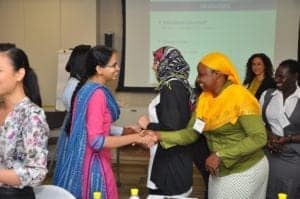Women continue to be underrepresented in executive positions. This holds true in every part of the world, in the financial sector and elsewhere. Even though studies show that companies with women in leadership roles perform better financially, and show higher returns on investment and equity as well as higher stock prices, lack of gender diversity at the top persists.
Having women in senior roles also brings value beyond financial performance. Research has shown that women score high on many leadership skills including: focus on mission and performance; relational skills like collaboration, teamwork, and connection; engaging and empowering others; sharing information and giving feedback; creativity and care for employees, customers, community; as well as good governance and ethics. So despite all the evidence that women leaders are good for business, what keeps more women from reaching the top tiers of their organizations?
As Women’s World Banking celebrates the tenth anniversary of our Women in Leadership Program, we are taking a close look at the factors that continue to block women’s advancement, so that we can keep making strides toward clearing those pathways.
Five persistent gaps to advancing women leaders:
- Representation
Today, approximately 50% of hires in financial services are women. Yet at 150 major financial institutions worldwide, only 13% of executive committee (ExCo) members are women. Women in ExCo positions also typically tend to be found in support functions– for example heads of Audit, Legal, Compliance, and HR—as opposed to Profit and Loss “P&L” roles.
More than a third of ExCos include no women at all, and only 4% of CEOs at those organizations are women. While in some countries, the overall numbers improved between 2008 and 2013, in others including the U.S., the numbers of women ExCo members declined.
- Visibility
Men tend to hold higher-visibility roles at companies, with more P&L responsibility, more international experience, a larger number of direct reports and a bigger budget to manage. A 2012 Catalyst study of graduates of top international business schools concluded that high-potential employees need three things to advance: highly visible projects, mission-critical roles, and international experience. Male graduates in the study significantly outpaced women in all three areas.
- Confidence
 Men are more likely to overestimate their abilities and performance, while women often underestimate both. Something called the Impostor Syndrome is another factor that can negatively impact women’s confidence: The belief—usually held by high-achieving individuals—that they are unqualified and will be exposed as frauds, may lead women to undersell their achievements and lose out on opportunities to advance.
Men are more likely to overestimate their abilities and performance, while women often underestimate both. Something called the Impostor Syndrome is another factor that can negatively impact women’s confidence: The belief—usually held by high-achieving individuals—that they are unqualified and will be exposed as frauds, may lead women to undersell their achievements and lose out on opportunities to advance.
- Perception Bias
When women and men receive different feedback at work, stereotypical perceptions can translate into lower access to leadership positions. A Kieran Snyder study of 177 reviews showed that 58.9% of men’s reviews contained critical remarks, while 87.9% of women’s reviews did. The critiques women received were also often personal rather than skills-based or constructive; for instance, women were frequently called “abrasive.” This word was never used to describe men.
Another study conducted by Stanford researchers found that women were 2.5x more likely than men to have their communication style characterized as “aggressive.” The study also found “supportive” and “helpful” applied more often to women whose praise tends to focus on team, rather than individual, outcomes. Men are twice as likely to be praised for their “drive” and “vision” and receive more feedback tied to individual successes and business results.
- Mentorship and Sponsorship
According to a study by Center for Work-Life Policy, men are 46% more likely than women to have a sponsor—a person in a senior leadership role who is willing to spend political capital advocating for them and advancing their careers. People with sponsors are more likely to ask for a raise or a stretch assignment, and report higher satisfaction with their career advancement prospects. But getting a sponsor usually means asking for one, something men are more likely than women to do, according to the study.
What can be done to overcome obstacles and advance gender diversity at the top?
The Leadership and Diversity for Innovation Program is one way that Women’s World Banking is moving the needle. The program is specifically designed to address the challenges that women face in their ascent to leadership, and to create champions for a more inclusive and innovative organizational culture.

The executives in the Program work on becoming more strategic leaders and more active in developing diverse talent. The women leaders build their core skills and enunciate a vision for their future leadership. In addition, the executives involve the women leaders in their business challenge and support their professional development. So far, the increased confidence, visibility and sponsorship have paid off:
- One high-potential woman leader left the program with the confidence and influencing skills to make a case for a bigger budget, more staff and a bigger office space. She got it!
- Another woman leader gained visibility by becoming involved in her senior executive’s strategic business challenge, a major organizational transformation. In this role, the woman leader stretched from regional operations to a risk focus and earned a promotion.
- An executive participant started coaching the high-potential woman he selected and his sponsorship helped her move into a more strategic role. Even though they are no longer in the same department, the coaching relationship continues.
If you are an executive in a financial institution, mobile network operator, fintech or regulatory institution committed to financial inclusion for low-income women, apply now to attend the 2017 LDIP.



